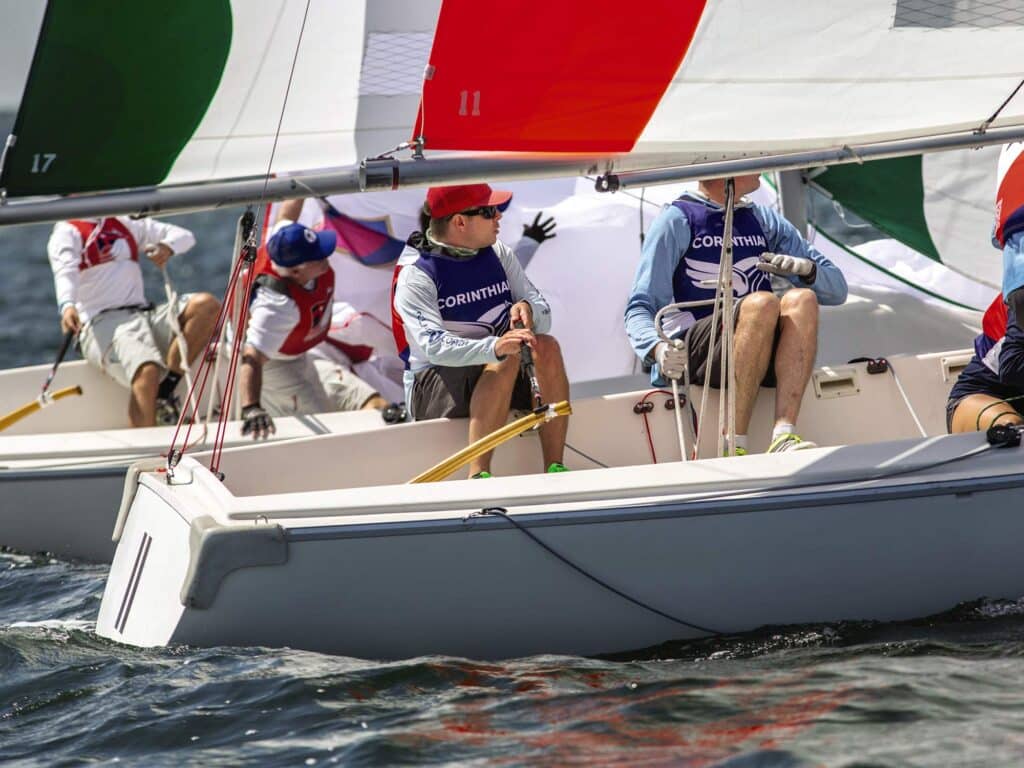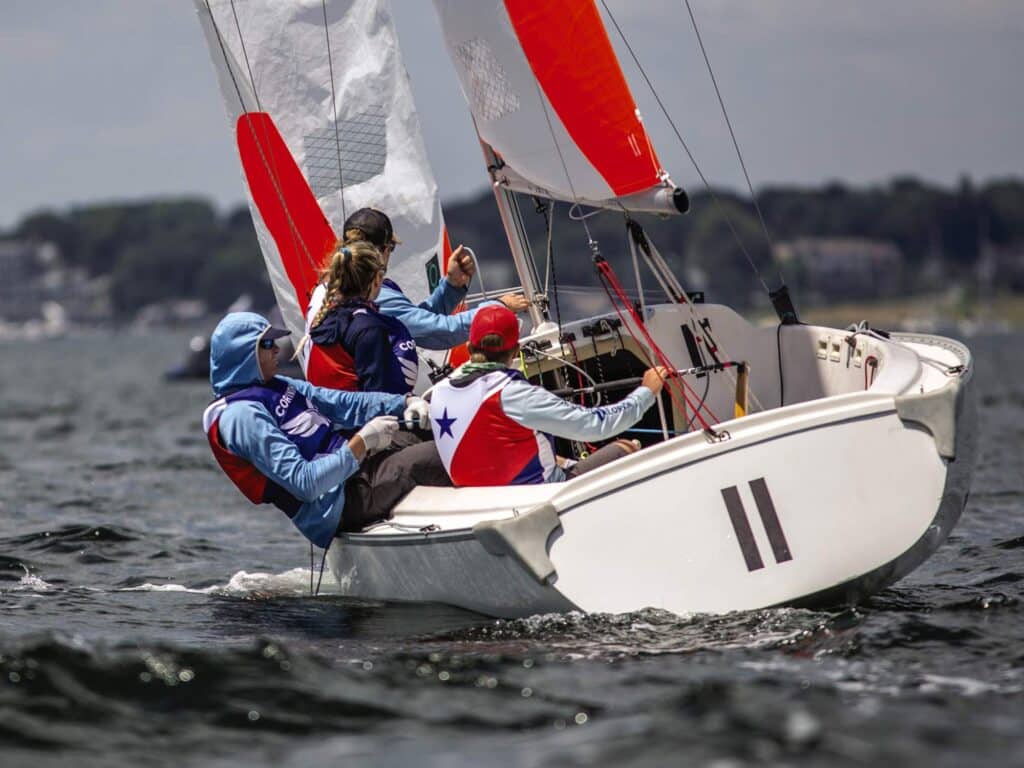
For Doug Sabin, one approach to getting more of his yacht-club peers active and on the water was simple: adult team racing. Sailing’s energetic and all-encompassing discipline, Sabin knew, would appeal to younger members at Marblehead’s Corinthian YC, and he was right. Corinthian’s success in building a team-racing program and engaging its membership in a new and exciting way is a great example for any club or organization looking to jump-start its stagnant sailing program.
Team racing is a strategic battle where boat position, clever tactics, precise boathandling, tactical skill and teamwork are the ingredients for success. The top teams practice maneuvers to gain an advantage. When one team is winning, it is on defense, and when a team is losing, they are on offense. Like other sports, including basketball and hockey, there are man-to-man matchups and zone defenses. It is a fast-moving game as positions change. Sailors must be quick at math as the scores change. The most popular format is three boats versus three matches. Watch a competitive intercollegiate team race and you will see teams attacking and trading the lead during fast-paced maneuvers at turning marks. Often there will be a lot of noise during these moments, although the best teams are remarkably quiet as they execute their plays. Champion teams are fluid and make it look like ballet.
It’s no surprise to me that participation in team racing has grown dramatically over the past 20 years in several yacht clubs—domestically and abroad. Clubs that have invested in building and growing their programs have seen membership rosters grow as a direct result. Sabin, who sailed at MIT, says the stakeholders at Corinthian recognized that providing boats for sailing is one viable way to attract young members.
When they initiated the team-racing program, they borrowed boats, but as the local one-design Sonar fleet faded, the three yacht clubs on Marblehead Harbor (Corinthian, Eastern and Boston) purchased a dozen used Sonars, which allowed them to have two sets of boats for team racing.
“For most of my career, Eastern and Boston were the strongest sailing clubs in the harbor,” Sabin says. “Thanks to team racing, Corinthian is now a very strong sailing club.”
If there’s any doubt to Sabin’s assessment of Corinthian’s competitive standing today, consider that he, along with younger members Wade Waddell, Miranda Bakos and Duncan Swain, won the New York YC Resolute Cup last September. That win qualified Corinthian for the Rolex NYYC Invitational Cup in the fall of 2023, the club’s marquee international amateur keelboat championship.
While the Resolute Cup was a fleet-racing competition, Sabin says their triumph over many of the United States’ premier yacht-club teams was in a large part due to their team-racing focus. “None of us had sailed in the Resolute [Cup] before. The reason we were successful is that we have this tight definition of what keelboat sailing is at Corinthian. So, we could fall into our roles and work together as a team very quickly. We practiced in an RS21 against Eastern YC for about two weeks before the regatta. We all knew how to communicate, and we knew our roles because of team racing.”
For Corinthian to get its team race program up and running at full speed, it tapped two-time Olympian Tim Wadlow. “For us, it was connecting with the college sailors. It’s all about youth and bringing those people into the club. Tim is a team-racing world champion, and with people of that level, we got into organized practices. He encouraged us to use spinnakers, which really changes the game quite a bit. The game really begins at the windward mark with the spinnaker because you are so much more powerful downwind. Tim understood that and made it part of our practice.”
For a yacht club to acquire a fleet of boats requires a big investment, but the use of small and stable keelboats allows for a wider range of ages to get in on the action. Sabin says they’re hoping to purchase a new fleet of Sonars that would be owned by all three yacht clubs within the next year. “Both New York YC and Seawanhaka Corinthian YC (in New York) have fleets,” Sabin says. “We are following their model.”

The Annapolis YC has ordered a fleet of 14 new Sonars with the goal of upgrading members’ team-racing skills and attracting new members. Past commodore Jonathan Bartlett, who initiated the program, says: “The biggest reason we ordered the boats was to go play in the team-racing arena. We have to learn to sail the boats and how they race. Where is the best team racing? It’s in New England.”
Sonars, designed by Bruce Kirby and first built in 1980, are now being built in England, where the only set of molds still exists. Bartlett credits Annapolis YC’s incoming rear commodore, Ted Kaczmarski, for selecting the Sonar and convincing the club’s board to provide the funding, saying, “It is a good investment.”
Creating a fleet of yacht-club-owned boats is a big operational and financial undertaking. As with all boats, there are considerations and budgeting for storage requirements, routine maintenance, insurance costs, and equitable scheduling of the use of the fleet among members. There is a long list of possible applications for a fleet of boats in addition to team racing, which could include adult-program sailing instruction, recreational daysailing, clinics, weeknight races and invitational regattas. Some clubs maintain two sets of sails for their fleet, one for recreation and instruction, and another reserved for racing. Including the club’s burgee on the sails and naming the boats after club luminaries, donors or famous yachts add to the spirit. Also, it’s important that a fleet be maintained equally so the boats sail at the same speed.
Another important consideration is to make sure the boats can launch easily. Minimal time preparing for sailing or putting boats away is an attractive factor. An organization looking to purchase a fleet for the first time might consider an existing fleet of used boats. A few sources of funding might include a grant from a club, a group of members creating a syndicate to purchase individual boats, donations, charter fees (try to keep fees at a modest level) or foundation grants. The class of boat selected is an important factor. The selection criteria centers around the cost, storage, typical sailing venue and number of crew. It must, of course, be a suitable boat for the prevailing wind conditions.
Team racing is practiced by people of all ages—the Hinman Masters and Hinman Grandmasters regattas are popular events—and the engagement goes beyond younger sailors. Corinthian’s program, Sabin says, has boosted participation among female members, which resulted in the creation of the Thayer Cup, its first women’s team-racing regatta using spinnakers.
A team race event typically engages many other supporting roles as well, from race officials to umpires and volunteers. “We always use umpires for our planned events,” Sabin says. “We don’t use umpires for practices or for pickup team racing on Thursday nights.”
Umpires, he adds, typically take the time to discuss on-the-water calls with competitors after racing, which makes it a learning experience for everyone. They want to make accurate rulings and learn from the sailors’ input. It is a two-way street, and I would add that damage deposits at regattas are an effective deterrent to collisions.
My first article in this magazine appeared in the spring of 1974, and at the time, I advocated for team racing to be included in the Olympic Games. Now, 49 years later, I still believe sailing at the Olympics could use freshening up. The Games hosts 10 classes, and team racing would be a welcome addition and generate top international competition with exciting, fast-paced, athletic sailing on a small course that’s certainly broadcast-friendly.
Perhaps it’s time we have that conversation again.









